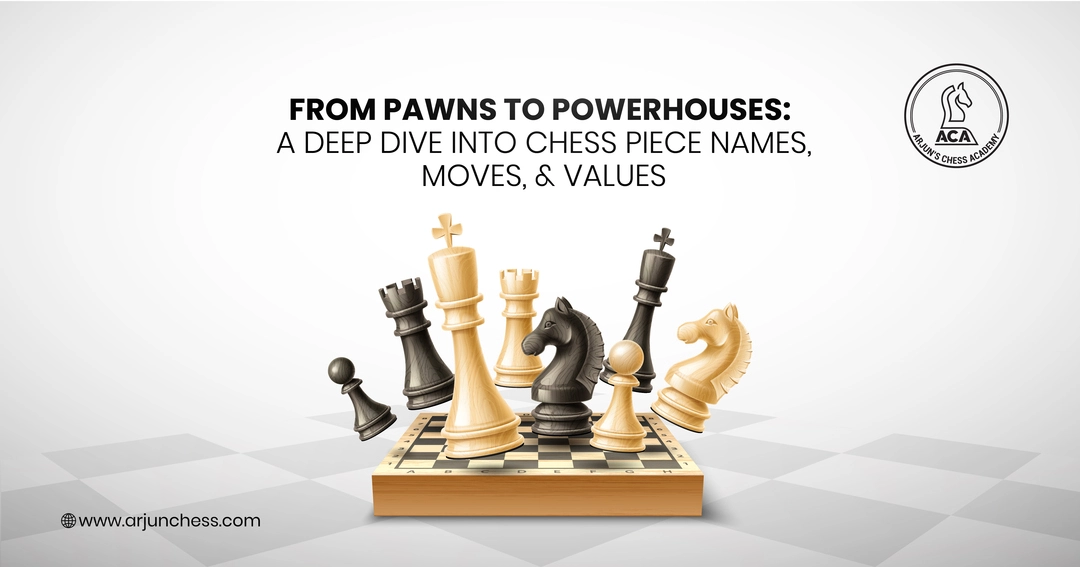
From Pawns to Powerhouses: A Deep Dive into Chess Pieces Names, Moves and Value
Unveiling the Royal Court: Meet the Movers and Shakers chess pieces
What do we move in a chess board to win? If this question has ever puzzled you, remember, knowing the chess pieces names, chess pieces moves and their value is the key that would transform your game.
Chess pieces are the blocks that you move while playing chess. There are 6 different types of chess pieces namely:
- King
- Queen
- Rook
- Bishop
- Knight
- Pawn
These pieces form the 32 members of the chess board with distinct moves and dynamic potential. Each side of a chess board starts with 16 pieces:
- Eight pawns
- Two bishops
- Two knights
- Two rooks
- One queen
- One king
Come let’s learn what they can do and how they do it!

The Regal King in chess: Mastermind of the Match
In a historic game, Bobby Fischer once remarked, “The King is a strong piece. Use it like a battering ram”.
The King is the heart of chess, the most important yet not so powerful piece. The King has limited moves; it can only move (or capture) one square in any direction. Top of Form.
But it has very unique defensive castling moves and cannot be captured. The victory lies with the King; if the King is attacked, it’s called a checkmate! Since the goal of chess game is to checkmate the King, protecting the King is a crucial job for other chess pieces.
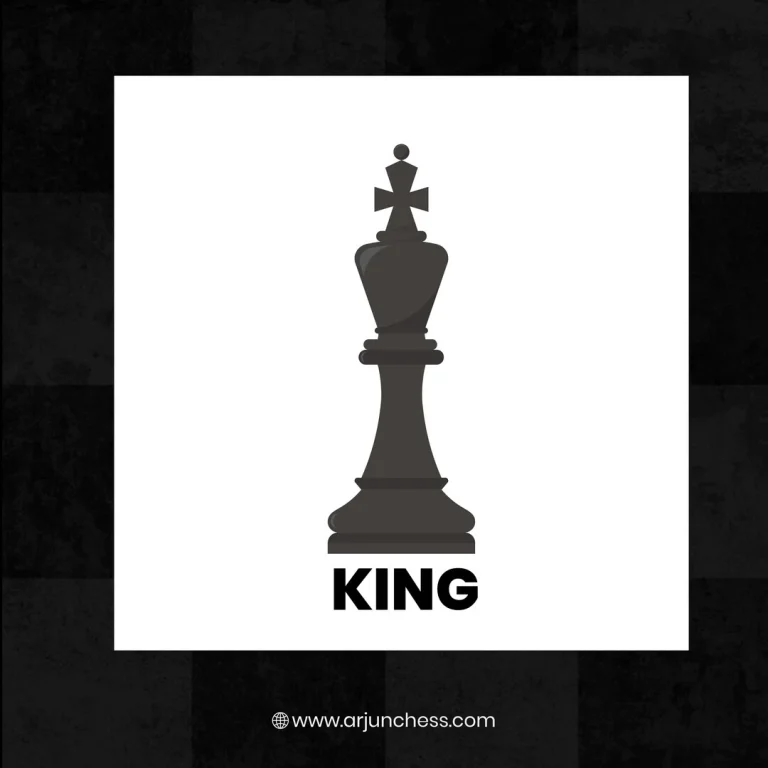
The Unstoppable Queen in chess: A Force of Nature on the Board
The Queen is the most versatile and powerful piece in chess.
It dominates the chessboard with the ability to move any number of squares along horizontal rows called ranks, vertical columns called files, or diagonally like the Bishops. Queen is capable of influencing the game’s outcome significantly.
For instance, the Queen can control key diagonals and ranks and threaten multiple pieces simultaneously, forcing the opponent into a critical position. The Queen can never be overlooked in a game because the piece can move like the Rook and Bishop combined, completely changing the course of the game.
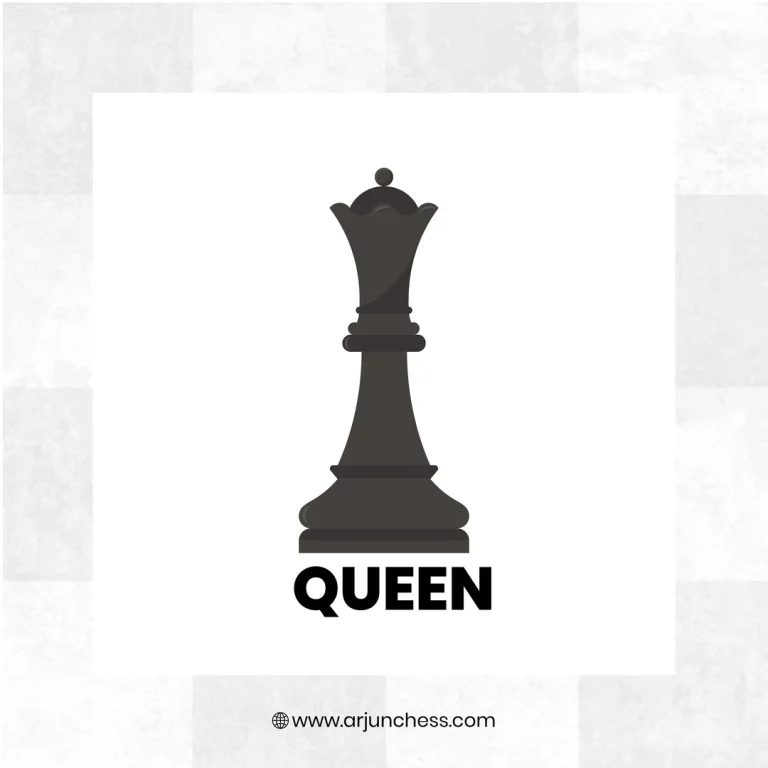
Towers of Terror: Introducing the Rook in chess: Guardians of the Ranks
There are 2 Rooks and million possibilities in chess owing to their ability to move horizontally or vertically across the board exerting dominance over ranks and files.
Positioned on either sides- on King’s side and Queen’s side, in all 4 corners of the chessboard, Rooks strategically penetrate into enemy territory, and creates threats.
Its straight-line movement provides unique control, influencing vast sections of the chessboard Rook coordination along open files is a pivotal aspect of endgame strategy, enabling players to fortify positions and mount powerful offensives. Having command over Rook movements will guard your game till victory.

Weaving Webs of Power: The Bishops Take the Stage in chess: Diagonal Dominators
Bishops are one of the minor yet equally powerful pieces in chess. The 2 Bishops’ unique trait lies in their diagonal prowess and pin-creating abilities that allow players to control critical lines on the board, restricting opponent pieces.
Bishops uses strategically thought out cooperative methods while collaborating their diagonal movements to create formidable network. Expert players work with the Bishop’s diagonal influence to unleash coordinated attacks, and manipulate the board to gain a strategic advantage.
A bishop can move freely diagonally as many squares as it likes, as long as its movement is not restricted by its own pieces or an occupied square. Bishops can capture an enemy piece by moving to the occupied square where the piece is located, making it a crucial component for the players.
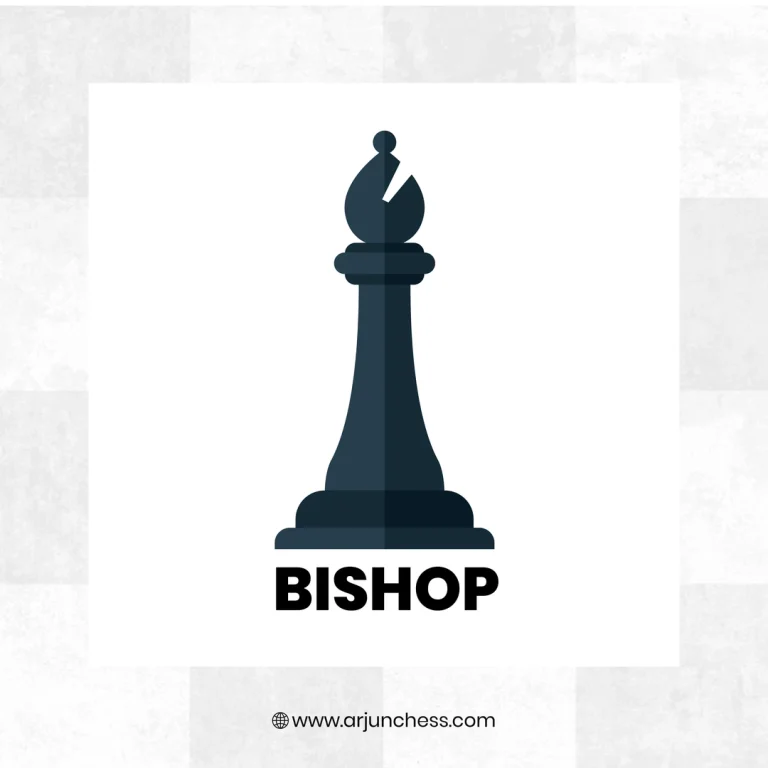
Leaping Warriors: The Unpredictable Knights in chess: Masters of the L-Shaped Dance
The Knight, with its distinctive L- shaped movement, moves in a manner unlike other chess pieces, leaping over obstacles.
This unique ability grants Knights strategic advantages, enabling surprise attacks and positioning in hard-to-reach places.
Knights excel in executing fork patterns, simultaneously attacking multiple enemy pieces. Their unpredictable movements and fork-based tactics make Knights invaluable tools for players, creating opportunities to disrupt opponents’ plans and secure advantageous positions on the chessboard. Astute players harness the Knight’s dynamic capabilities to navigate the complexities of the game, employing them as versatile and unpredictable assets in their strategic arsenal.

Humble Heroes: The Pawns March On in chess: From Foot Soldiers to Queens
Pawns are the foot soldiers of chess. They move forward but capture diagonally. Pawns are regarded as least powerful pieces because of their limited movements.
For instance, if a pawn has already moved, then it can move forward just one square at a time. However they harbor potential for promotion upon reaching the eighth rank. This transforms them into powerful pieces, often altering the game’s dynamics.
In endgames, Pawns play unique roles, acting as crucial defensive barriers or advancing to support checkmating combinations. Masters recognize the subtle strength of Pawns, understanding their significance in shaping the board’s landscape and influencing the outcome of the game, especially during the critical stages of promotion and endgame maneuvers.

Unlocking Their Secrets: Mastering Chess Piece Moves
Endless possibilities- that’s what makes Chess a beautiful game. But to enjoy the true marvel of chess, it’s important to master the moves. The rules of chess are simple. However it takes right guidance and practice to ace it. For chess tips and hacks, check out our previous blog post 15 Essential Chess Tips and Tricks for Beginners – A Comprehensive Guide.
Now let’s walk you through the primary moves of the Chess pieces for you to find your way with the game beginning with the King, the game stopper:
Kingly Maneuvers: A Dignified Stroll across the Squares
- The King, with its limited yet vital one-square movement, can move across the chessboard in all directions, horizontally, vertically, and diagonally. This cautious mobility defines its role as the game’s linchpin.
- The King can move anywhere on the board except on squares occupied by one of the player’s own pieces or pawns. When the King is under threat, the concept of “check” arises, demanding immediate action.
- The King’s strategic importance lies in skillful evasion of such threats and moving out of harm’s way to escape check and avoid the perilous threat of checkmate.
Unbridled Freedom with Unmatched Mobility, Queen in chess
The Queen is the symbol of unmatched power and freedom. She can move any number of squares in any direction. This versatility grants her a formidable attacking power, dominating both diagonals and ranks with ease.
The Queen has the ability to command the battlefield. Whether by swiftly crossing the board to threaten the opponent’s backline or pivoting dynamically between columns, the Queen dictates the tempo of the game. Her unrestricted mobility and versatility makes her the cornerstone of any skilled player’s offensive weapon.
The Queen dictates the tempo of the game. Her dominance exemplifies chess’s dynamic nature, making her a cornerstone of any skilled player’s weapons.
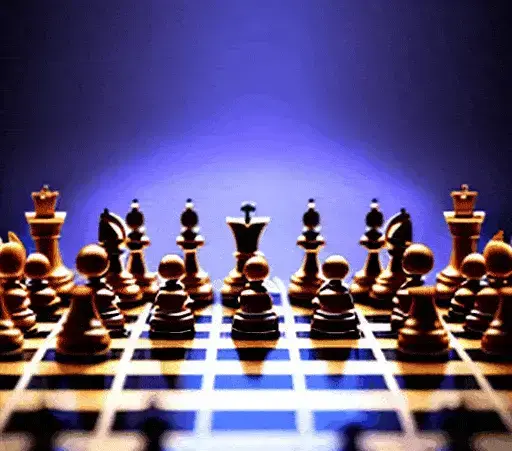
Knowing Their Worth: Understanding Chess Piece Value
Each chess piece has a value. These chess piece values dictates its worth and how they relate to each other. Their values differs according to their individual strengths and weaknesses. Having an idea about the relative worth of each piece helps a player evaluate their moves.
Let’s take a closer look at the chess piece values!
A lot of the chess moves depends on knowing which pieces should be traded for another piece and how we should evaluate an exchange. Remember, each piece’s value is directly linked to its strength.
Here’s what you should know about each piece!
The Pawn's Humble Price and Hidden Potential
A Pawn is worth a point and that may make it seem inconspicuous. But their potential for promotion adds strategic depth.
Underestimating a Pawn can lead to perilous consequences, as neglecting their advance may result in a transformed force. A pawn’s seemingly humble role becomes critical when its promotion disrupts the opponent’s strategy, turning a potential liability into a game-changing asset.
The infamous “Pawn Fork” is a good example of how underestimating a Pawn’s significance can lead to strategic blunders. Dismissing the pawn’s potential, a player might inadvertently expose a valuable piece to a pawn’s attack. This oversight often results in a forced decision between sacrificing the piece or suffering material loss.
The Knight's Three Points and Strategic Maneuvering
The Knight has 3 points value.
It stands out for its distinctive L – shaped movement, enabling unique tactical moves like forks. This versatility of the piece enables it to simultaneously attack two enemy pieces, creating a strategic dilemma for opponents.
In a classic fork example, a Knight might threaten both a Queen and a Rook, forcing the adversary to surrender one of these higher-value pieces. The Knight’s tactical prowess, coupled with its point value, makes it a dynamic asset in chess, capable of disrupting opponents’ plans and influencing the course of the game with strategic finesse.
Frequently Asked Questions
The Queen is the most powerful chess piece. With the ability to move any number of squares in any direction, she combines versatility and attacking power. Her strategic importance often determines the course of the game, making her the formidable cornerstone of any chess strategy.
The Pawn is the weakest chess piece, with limited one-square forward movement and a unique capturing diagonal. Although essential for pawn structures and potential promotion, individually, their restricted mobility defines their modest strength on the chessboard.
The goal of chess is to checkmate your opponent’s king, putting it in a position where it cannot escape capture. Strategic planning, tactical execution, and board control are essential to achieving checkmate while safeguarding your own king from threats.
Yes, chess is excellent for the brain. It enhances cognitive abilities like memory, problem-solving, and strategic thinking. Regular chess play has been linked to improved concentration, pattern recognition, and overall mental acuity, making it a valuable activity for brain health.

By

